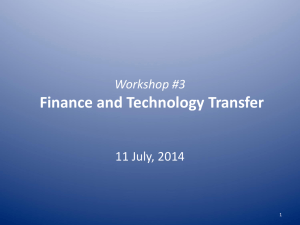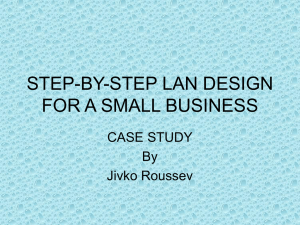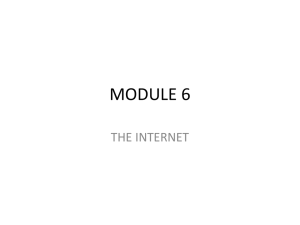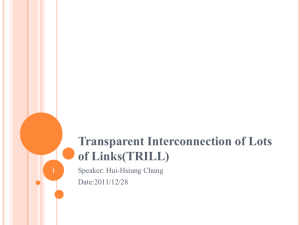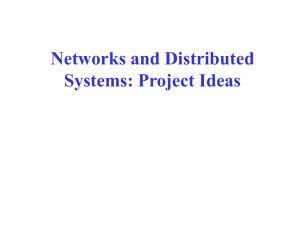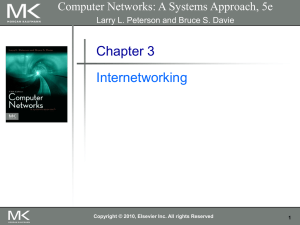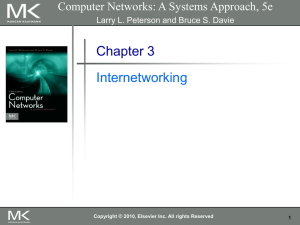Chapter 9 Slides - Hafr Al-Batin Community College (HBCC)
advertisement
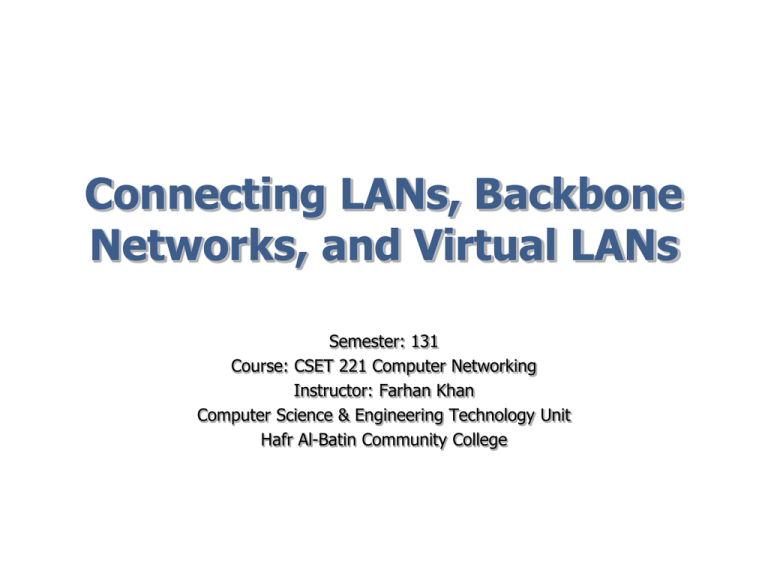
Connecting LANs, Backbone Networks, and Virtual LANs Semester: 131 Course: CSET 221 Computer Networking Instructor: Farhan Khan Computer Science & Engineering Technology Unit Hafr Al-Batin Community College Outline Connecting devices Backbone networks Virtual LANs 2 Connecting Devices 3 Layer-1 Connecting Devices 4 Repeaters Connected segments become single collision domain 5 Note A repeater connects segments of a LAN. 6 Note A repeater forwards every frame; it has no filtering capability. 7 Note A repeater is a regenerator, not an amplifier. 8 Repeater Function 9 Hubs Similar to multiport repeaters All segments belong to the same collision domain 10 Layer-2 Connecting Devices 11 Bridges Bridges process information up to the frame-level (Layer 2) Connecting LANs while separating collision domains Connected segments form a single network (same broadcast domain) 12 Main Functions of Bridges Three main functions: Forwarding / Filtering Address Learning Loop Avoidance 13 Forwarding/Filtering MAC addresses are used for forwarding / filtering Bridging and switching devices determine if incoming frames are destined for a device on the segment where they were generated. If so, the devices do not forward the frames to the other device ports. This is an example of filtering. If the MAC destination address is on another segment, the devices send the frames to the appropriate segment. This is known as forwarding. 14 Forwarding/Filtering If a frame destined for station 712B 13456142 arrives at port 1, the bridge consults its table to find the departing port. According to its table, frames for 712B 13456142 leave through port 1; therefore, there is no need for forwarding, and the frame is dropped. On the other hand, if a frame for 712B13456141 arrives at port 2, the departing port is port 1 and the frame is forwarded. 15 Note A bridge has a table used in filtering decisions. 16 Note A bridge does not change the physical (MAC) addresses in a frame. 15.17 Address Learning In order for the bridges to begin passing information to and from devices and segments, they must first familiarize themselves with the addresses associated with those devices and segments. Initially, they must let all information pass through them, even if that information is not intended for a device on the opposite side of the bridges/switches. This is known as flooding. Once the devices have allowed the information from the connecting segments to pass through, they can log the address information into tables called bridge table for further use in forwarding and filtering. Note: Bridges and switches create bridge table based on source Hardware address. 18 Address Learning AD EA BC 19 Loop Avoidance Transparent bridges work fine as long as there are no redundant bridges in the system. Systems administrators, however, like to have redundant bridges (more than one bridge between a pair of LANs) to make the system more reliable. Redundancy can create loops in the system, which is very undesirable. To solve the looping problem, bridges use the spanning tree algorithm to create a loopless topology. 20 Loop Problem 21 Graph Representation 22 Creating Spanning Tree 23 Blocking Ports 24 Types of Bridging Transparent Bridging Source Route Bridging Mixed-Media Bridging 25 Transparent Bridging Transparent bridging is a scheme found in Ethernet networks in which bridges pass frames along one hop at a time based on tables associating end nodes with bridge ports. The operation and presence of these bridges is transparent to network end nodes. Transparent bridges interconnect like-media LANs (for example, all Ethernet) to form the appearance of a single larger network. They also isolate intra-segment traffic, thereby reducing the traffic seen on each individual segment. 26 Source Route Bridging In Source-route bridging, the entire route to a destination is predetermined, prior to data transmission. The source places the complete source-to-destination route in the frame header of all frames. Source-route bridging (SRB) was developed by IBM for use in Token Ring networks. 27 Source Routing Bridging Example In the figure, the Path from A to D is L1, B1, L2, B2, L3. If the source doesn't know the route, it sends a "discovery frame" that goes to every LAN in the network. The destination replies and each bridge along the way put its ID in that reply. The source then knows all that it needs. This discovery produces lots of excess packets. 28 Mixed Media Bridging Mixed-media bridging involves moving frames from one LAN media to another, typically from Ethernet to Token Ring (and vice versa), but might also be from Ethernet to FDDI, and Token Ring to FDDI. The following figure shows a mixed-media bridge connecting Ethernet, Token Ring, and FDDI data links: 29 Switches Switches also referred to as multi-port bridges, automatically learn the MAC addresses of the devices connected to each port of the switch and builds switching table. The switch then examines each packet it receives to find destination MAC address, looks up the destination address in its switching table and determines outgoing interface. Like bridges, switches forward and flood traffic based on MAC addresses. However, because switching is performed in hardware instead of in software, it is significantly faster. 30 Switches 31 Switching Methods The three types of switching methods used by switches to forward data traffic: Store and Forward Cut-Through Fragment free 32 Store and Forward Switching With the store-and-forward switching method, the LAN switch copies the entire frame into its onboard buffers and computes the cyclic redundancy check (CRC). The frame is discarded if it contains a CRC error, or if it is a runt (less than 64 bytes including the CRC), or a giant (more than 1518 bytes including the CRC). If the frame does not contain any errors, the LAN switch looks up the destination address in its forwarding, or switching, table and determines the outgoing interface. It then forwards the frame toward its destination. 33 Cut-through Switching With the cut-through switching method, the LAN switch copies only the destination address (the first 6 bytes following the preamble) into its onboard buffers. It then looks up the destination address in its switching table, determines the outgoing interface and forwards the frame toward its destination. A cut-through switch provides reduced latency because it begins to forward the frame as soon as it reads the destination address and determines the outgoing interface. 34 Fragment-Free Switching This method works just like cut-through, but the switch waits for 64 bytes to be received before forwarding the first bytes of outgoing frame. According to Ethernet specifications, collisions should be detected during the first 64 bytes of the frame. Frame in error due to collision will not be forwarded. 35 Layer-3 Connecting Devices 36 Routers Capable of connecting networks of different types Routers separate networks into different broadcast domains 37 Routing Tables The routing information a router learns from its routing sources is placed in its routing table. The router will rely on this table to find which port to use when forwarding addressed packets. 38 Routing Tables If the destination network is directly connected, the router already knows the port to use when forwarding packet 39 Routing Tables If destination networks are not directly attached, then the router must learn the best route to use when forwarding packets. 40 Static and Dynamic Routing The two methods for learning routes through the network are as follows: Static routing - Routes learned by the router when an administrator manually establishes the route. The administrator must manually update this static route entry whenever a network topology change requires an update. Dynamic Routing - Routes dynamically learned by the router after an administrator configures a routing protocol that helps determine routes. Unlike static routes, once the network administrator enables dynamic routing, route knowledge is automatically updated by a routing process whenever new topology information is received from the network. 41 Backbone Networks Backbone Networks A backbone network allows several LANs to be connected. In a backbone network, no station is directly connected to the backbone; the stations are part of a LAN, and the backbone connects the LANs. Bus Backbone 44 Note In a bus backbone, the topology of the backbone is a bus. 45 Star Backbone 46 Note In a star backbone, the topology of the backbone is a star; the backbone is just one switch. 47 Connecting Remote LANs 48 Note A point-to-point link acts as a LAN in a remote backbone connected by remote bridges. 49 Virtual LANs Virtual LAN A virtual local area network (VLAN) is a set of workstations within a LAN that can communicate with each other as though they were on a single, isolated LAN. The basic reason for splitting a network into VLANs is to reduce data traffic congestion on a large LAN. 51 Regular Switch Three LANs are connected by a regular switch, forming one LAN (one broadcast domain) 52 Switch with VLAN Feature Different VLANs belong to different broadcast domains They are considered isolated networks 53 Multiple VLAN Switches Trunk Trunk 54 Note VLANs create broadcast domains. 55 Advantages Performance. Workstations could be separated off into separate LANs without being physically divided up by routers. Formation of virtual workgroups. Because workstations can be moved from one VLAN to another just by changing the configuration on switches, it is relatively easy to put all the people working together on a particular project all into a single VLAN. They can then more easily share files and resources with each other. 56 Advantages Greater flexibility. If users move their desks, or just move around the place with their laptops, then, if the VLANs are set up the right way, they can plug their PC in at the new location, and still be within the same VLAN. Ease of partitioning off resources. If there are servers or other equipment to which the network administrator wishes to limit access, then they can be put off into their own VLAN. 57 Routing Across VLANs Router is required to connect different VLANs Trunk Trunk Trunk 58 Summary Connecting devices Backbone networks Virtual LANs 59

